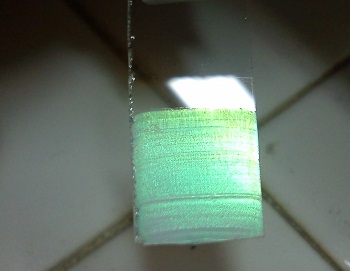
The opal-based sensor turns from green to red when it detects alcohol vapor. The fabricated bare opal, designed at the Università degli Studi di Palermo in Italy, measures 1 × 1.2 cm across and is 650 nm thick. Credit: R. Pernice et al, Università degli Studi di Palermo
A new class of optical materials based on polystyrene opals has properties ideal for fabricating better breathalyzers, say researchers in Italy. Typical breathalyzers are costly and imprecise, so Riccardo Pernice and colleagues at the Università degli Studi di Palermo in Italy used artificial opals to fabricate 3-D photonic crystals that are sensitive to ethanol vapor, a component used to detect alcohol on the breath (Opt. Mater. Express 3, 1820).
The proof-of-concept device involves a thin layer of fabricated opal pumped full of a hydrogel that swells when exposed to ethanol vapor. The opal material visibly changes color from green to red upon detection of alcohol, working like a sort of “litmus test” for intoxication. The peak Bragg wavelength increases from 576 nm for a water-saturated opal to 669 nm when saturated with ethanol vapor. While most color-changing sensors are too imprecise to detect alcohol concentration, the researchers incorporated an electronic system that accurately measures sensitivity equal to 2.4 × 10-3 nm/ppm. The advantage of such sensitivity, says Pernice, is the capability to detect much higher concentrations of ethanol than current breathalyzer technology. The breathalyzer device is also reusable multiple times, changing back to green in less than a minute. The device is therefore inexpensive and small enough to be portable in the field by law enforcement officials.
According to the researchers, the infiltrated opals are the first photonic-crystal-based structures to enable visual identification of ethanol vapor. The device is also insensitive to acetone, a vapor that can lead to false-positive readings in other portable sensors. The team plans to establish the low-end range of ethanol detection in future research.
